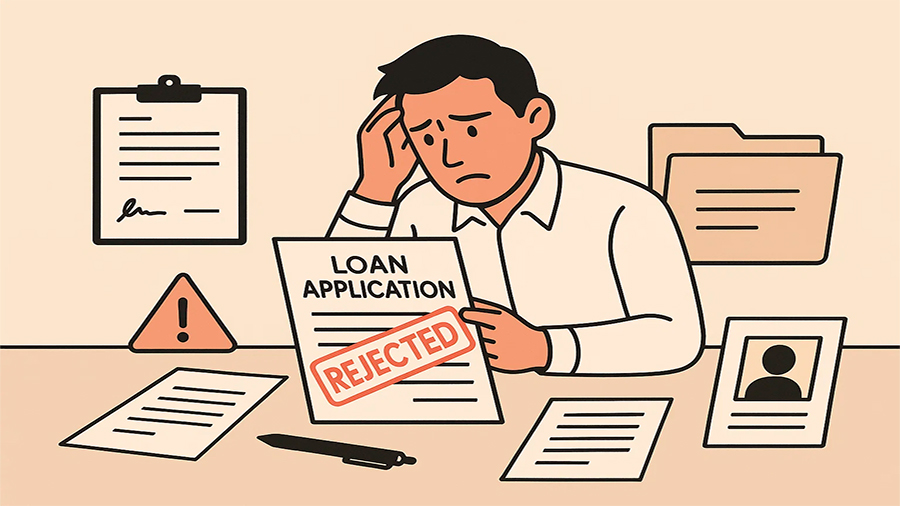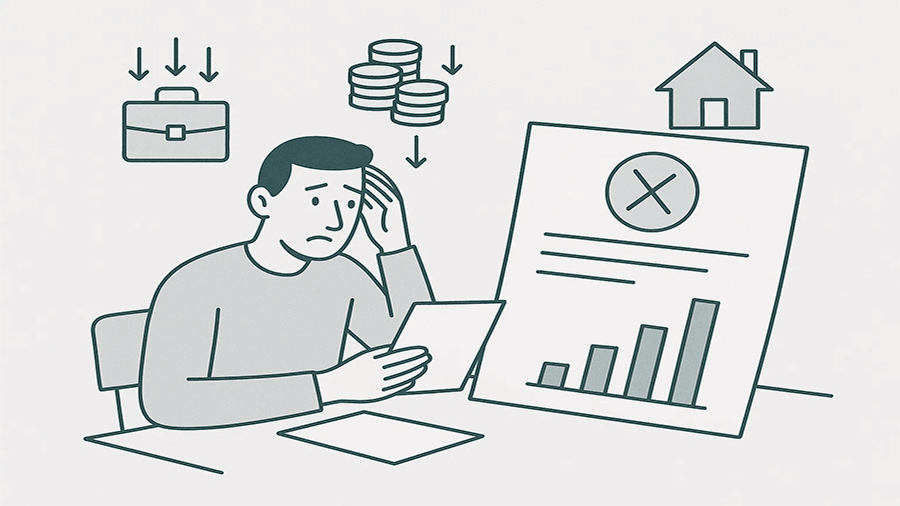Why Are You Denied a Loan: The Main Reasons
Understanding why a lender rejects your loan request is essential if you want to improve your chances next time. Financial institutions assess risk by analyzing your credit history, income stability, debt level, and repayment capacity. Even a strong application can fail if one or more key factors raise red flags. By breaking down the most common causes of refusal, we can pinpoint what needs fixing in your financial profile. Whether it’s a low credit score, inconsistent income, excessive debt, or inadequate documentation, each reason signals a specific area to strengthen for future approval.
Low Credit Score and Negative Credit History
A low credit score is one of the primary reasons loan applications fail. Lenders use credit scoring systems to predict how likely you are to repay. Scores below 600 often trigger automatic declines for many mainstream loan products. Past late payments, defaults, collections, or bankruptcies lower your score and indicate higher risk. Multiple recent credit inquiries can also be a warning sign, suggesting you may be desperate for funds. Improving your credit profile requires consistent on-time payments, reducing outstanding balances, and avoiding new debt until your score recovers. Monitoring your report regularly helps catch errors and dispute inaccuracies promptly.
Key Actions to Improve Your Credit Standing
- Pay all bills on or before the due date without exception.
- Reduce credit card utilization to below 30% of available limits.
- Clear small debts entirely to improve debt-to-income metrics.
- Limit new credit applications to avoid multiple hard inquiries.
High Debt-to-Income Ratio
A high debt-to-income (DTI) ratio can undermine an otherwise solid loan application. Lenders calculate DTI by dividing total monthly debt payments by gross monthly income. Ratios above 40–45% raise concerns that you may not manage additional repayments comfortably. Even if your credit score is excellent, too much existing debt can block new borrowing. Lowering your DTI requires either increasing income or reducing debt obligations. Consolidating high-interest debts into lower-rate products can help, as can aggressively paying down balances before applying. Lenders prefer applicants whose DTI leaves enough room for unexpected expenses without financial strain.
How to Reduce Your DTI Before Applying
- Negotiate higher income through salary reviews or side work.
- Pay off short-term obligations ahead of schedule.
- Refinance expensive loans to lower monthly payments.
- Avoid taking on new obligations in the months before applying.
Unstable or Insufficient Income
Lenders prioritize borrowers with predictable, adequate income to ensure consistent repayment capacity. Freelancers, seasonal workers, and those with irregular earnings face additional scrutiny. Even if your annual income appears high, variability month-to-month can be viewed as risky. Insufficient income relative to the loan amount requested is another common rejection factor. To strengthen your position, provide detailed proof of earnings over a longer period, such as two years. Supplementary income from rental properties, dividends, or part-time work can help. A stable job history, ideally with the same employer, signals reliability and can offset some perceived risk.
Documents That Strengthen Income Proof
- Recent pay stubs and employer verification letters.
- Two years of tax returns for self-employed applicants.
- Bank statements showing consistent deposits.
- Contracts or invoices confirming ongoing work commitments.
Insufficient Collateral or Security
Secured loans require valuable collateral to protect the lender if you default. If the collateral offered is insufficient or difficult to liquidate, approval becomes less likely. Properties with disputed titles, vehicles with outstanding liens, or assets that depreciate rapidly may not qualify. The loan-to-value (LTV) ratio — the amount borrowed compared to the collateral value — is a critical factor. Lenders typically prefer an LTV of 80% or less. To improve your chances, offer high-quality collateral, ensure clear ownership documentation, and avoid overvaluing assets. Strong collateral can sometimes compensate for minor weaknesses in other parts of your application.
Examples of Acceptable Collateral
- Real estate with verified title and no legal disputes.
- Vehicles free of financing or liens.
- Cash deposits or certificates of deposit.
- Investment portfolios with stable, transferable assets.
Incomplete or Inaccurate Documentation
Even financially strong applicants are denied if paperwork is incomplete, inconsistent, or inaccurate. Missing documents, unsigned forms, or discrepancies between stated and verified information create doubts about credibility. Lenders must meet regulatory requirements, and errors slow the process or cause outright refusal. Double-check every form, verify that all dates and figures match official records, and submit documents in the required format. Providing more than the minimum requested — such as additional identification or extra income proof — can demonstrate preparedness and professionalism, which often works in your favor.

Recent Negative Financial Events
Recent bankruptcies, foreclosures, charge-offs, or court judgments significantly reduce your approval chances. Even if your current financial position has improved, lenders may apply mandatory waiting periods after such events. These can range from one year for minor delinquencies to seven years for major bankruptcies. During this time, focus on rebuilding your profile: establish new accounts in good standing, maintain a perfect payment record, and reduce overall debt. Documenting recovery efforts shows future lenders that past issues are resolved and unlikely to repeat.
Applying for the Wrong Loan Product
Submitting an application for a product that doesn’t match your profile often leads to rejection. For example, applying for a large unsecured personal loan with average credit may be unrealistic. Understanding each product’s requirements helps avoid wasted applications and unnecessary credit inquiries. Research the lender’s eligibility criteria before applying, and if possible, use pre-qualification tools that don’t impact your credit score. Matching your request to the right product not only improves approval odds but can also secure more favorable terms and interest rates.
Failure to Meet Minimum Requirements
Every lender sets baseline requirements, which can include minimum age, residency status, employment type, and income thresholds. Falling short on any single factor can result in automatic rejection regardless of other strengths. For example, some lenders will not approve loans for applicants employed less than six months in their current job. Carefully review published requirements before applying. If you fall short, consider waiting until your circumstances improve or applying with a co-signer who meets all criteria. Meeting every baseline requirement prevents unnecessary declines that could have been avoided with better timing.
The Conclusion
Knowing why lenders reject applications empowers you to address weaknesses directly. Every decline stems from specific, identifiable factors — whether it’s credit health, income stability, debt levels, collateral value, or documentation quality. By approaching the application process with a clear understanding of these areas, we can significantly improve approval odds and negotiate better terms.


